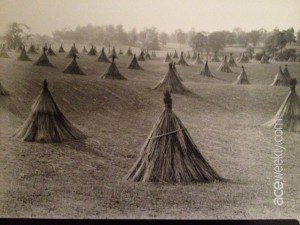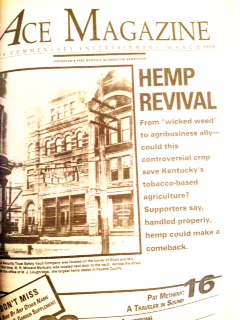The History of Hemp in Lexington, Kentucky
By J.F. McKeighen
March 11, 1995

The first recorded crop of hemp in Kentucky was raised outside of Danville in 1775. However, hemp growing was encouraged since the beginning of the colonization of North America. In pioneer times, hemp was grown domestically for its fiber, which was spun and woven into cloth or rope or traded for other goods. After the American Revolution, as people streamed into the Kentucky territory, the seed became expensive and hard to find. It was 1788 before Robert Barr of Lexington advertised a quantity of hemp seed for sale in the Kentucky Gazette.
By 1790, it was common to see notices in the Gazette from merchants willing to trade merchandise for beef, pork, hemp, ginseng, tobacco or good whiskey. Almost anyone could grow enough for their own needs and trade the surplus.
Unfortunately, ginseng was the only thing produced in the state which could bear the high cost of shipment east, and there wasn’t much of it around. In June 1787, General James Wilkinson floated a fleet of flatboats to New Orleans, closed to American trade by Spain for three years, and managed to secure the exclusive right to trade in New Orleans until December, 1788, when the Spanish decided to allow anyone to trade for a fifteen percent duty.
 At that time, Lexington was booming as a supply hub for points west. Merchants opened stores and sold just about anything they could purchase from the east. Since they had a year to pay, merchants could easily float bartered raw goods or, more commonly, manufactured products to New Orleans, sell them and then pay for their purchases.
At that time, Lexington was booming as a supply hub for points west. Merchants opened stores and sold just about anything they could purchase from the east. Since they had a year to pay, merchants could easily float bartered raw goods or, more commonly, manufactured products to New Orleans, sell them and then pay for their purchases.
Hemp manufacturing was a source of wealth for many Bluegrass families between 1770 and 1860. With the invention of the cotton gin in the 1790s, cotton soon replaced hemp as fibers for making clothes. However, the ginned cotton had to be compressed into bales so it could be economically transported. The bales were wrapped with hemp bagging and tied with hemp twine.
Thomas Hart and Sons, who were soon to become substantial Lexington merchants, announced in 1794 that they would be moving to the state the following spring from the east to take advantage of the influx of pioneers and to begin the manufacture of flour, nails, and rope.
Lexington merchants Peter January and his son Thomas opened the first ropewalk or rope factory on Mill Street between Second and Third. By the turn of the century, David Dodge, James Weir, John W. Hunt and Charles Wilkins also opened ropewalks and consistently advertised for raw cleaned hemp or for experienced ropemakers.
John W. Hunt and John Brand are believed to be the first to open a factory to produce bagging in 1803. By the time of his death, Brand had an estate of over a half a million dollars and had built Rose Hill at the corner of Fifth and Limestone. Hunt, who built the Hunt-Morgan home at the corner of Mill and Second, was reportedly the wealthiest merchant and manufacturer in Lexington.
After planting in well-prepared fields, a hemp crop took about 120 days to mature. Bottom land by the Kentucky river was used primarily to grow hemp for seed, which was grown differently than hemp for fiber. When mature, the plants were cut by hand, and the stalks were kept on the ground until they were dry. When dry, they were taken up and placed in shocks and left in the fields until late fall or winter.
The hemp fiber is attached to the woody inner portion of the plant by a resinous gum. It was necessary to loosen the fiber before the “hand brakes” — used to separate the fiber or “lint” from the stalks — would work. This process was called “rotting.” The simplest, least expensive, and most common method used in the bluegrass was the “dew rotting” process. This produced a poor quality fiber or varying consistency, but was adequate for the manufacture of bagging and twine.
Hemp rotted in cold weather produced a fine, white fiber or even texture not possible in warm weather. About November, the shocks were broken open and “the dried plants were spread evenly about the field on the ground.” If the plants remained on the ground too long, the strength of the fiber was reduced. If not long enough, the fiber couldn’t be cleaned well. The process was usually completed in four to six weeks, and the hemp was again raked into small bundles and stacked in small shocks to await the breakers.

J.F. Hopkins writes in The Hemp Industry of Kentucky: “The laborious task of hemp breaking began soon after Christmas. the brakes were moved from shock to shock over the field to avoid the necessity of carrying hemp straw, and often the operator kept a fire burning near for the double purpose of keeping himself warm and of drying the hemp. The work was monotonous and intriguing, requiring a considerable strength and skill on the part of the laborer. Holding a small bundle of stalks in his left hand, he placed their tops across the lower slats of the brake, then with repeated strokes, brought the upper frame down sharply upon them. The shearing action broke the wood into small pieces, called hurds or shives, which were shaken out by whipping the bundle against the machine or against a stake, or by striking it with a paddle. By continuing the process of alternately breaking and whipping, the lint was freed from the wood along its entire length.” The process Hopkins describes would only work in dry weather.
In Fayette County, slaves were commonly used for breaking hemp. It was said that this was a popular job because it paid a penny a pound for any production over the task amount, which was commonly 80 to 100 pounds a day. “Two hundred pounds a day was not an unusually high production for a skilled workman, and at least one slave is known to have broken 360 pounds [in one day].”
Slave labor was used to a large extent in the manufacturing process as well. Manufacturers would “own” the workers, or hire them from their owners. In 1834, the cost of hiring a slave experienced in weaving or rope making was between $30 and $80 a year. Since manufacturing was also a “tasked” job, in the 1850s, a slave could make “$2 to $3 a week which he was free to spend as he chose.” Some slaves are said to have saved the money they earned to buy their freedom and move North.
Rope was manufactured in long narrow buildings called “ropewalks.” Hemp lint was cleaned or “hackled” by pulling it across a board covered on one side by small sharp spikes. This was done in the “hackling house.” The Lexington Observer and Kentucky Reporter of March 1836 describes one such house, “One of the larger establishments, opened by Gratz and Bruce in Lexington, included for the manufacture of a bagging a ‘calendar and hemp house’ capable of storing 60 tons of hemp.” The hackling house was 18 by 30 feet, the “factory” 195 by 25 feet and included “two stories, calculated for 12 spinners each story, and attached to the factory a weaving house which contained spindles and looms.” For the manufacturing of rope, there was a brick hemp house 40 by 50 feet and two stories high, storing about 200 tons of hemp, a brick spinning house 180 by 32 feet, and a ropewalk extending 600 feet.

The European wars in the early 19th century greatly helped the producers and manufacturers of hemp. In 1810, Kentucky had 38 ropewalks, more than any other state. Thirteen of these were in Fayette County. There were 13 bagging factories in Kentucky, altogether producing 453,750 yards of bailing cloth, 300,000 yards of which were produced by five factories in Fayette County. Most of this was made by hand, and it was estimated that there were 1000 old hand looms in Fayette County alone. At this time, Lexington was the principal industrial city of the state of Kentucky.
After the war of 1812, cotton production increased tremendously and demand for bagging and twine also increased. Until the 1860s, growing and manufacturing hemp was generally profitable, but weather conditions always affected the supply and the prices manufacturers would pay farmers for their crops. Also, tariffs placed on the import of twine and bagging affected the profits of the factory owners.
The 1830s and 1840s were a particularly good time for the hemp industry and for Lexington. In 1831, Lexington exported an estimated $2,750,000 of goods, of which $750,000 was thought to be hemp-related, and was producing one million yards of bagging and two million pounds of cordage. Louisville was the nearest rival, processing 600 tons of hemp a year.
The Lexington and Ohio Railroad was chartered in 1830, and by 1835 there was a rail line to the Kentucky River at Frankfort. New machines were invented in the 1830s but were largely ignored in Lexington factories, which continued to use the same primitive methods of production.
In 1841, Andrew Caldwell of Lexington began operation of a machine he had invented which accepted raw fiber, hackled, spun, and wove the bagging. He claimed a 30-yard-per-hour output. However, most inventions were adopted slowly, if at all by the hemp industry in Kentucky, and due to primitive production techniques, the Kentucky product was usually of poor quality or inconsistent at best. By 1860, when most factories were steam- powered, most in Kentucky and all in Lexington were still powered by horse or hand. Other areas of the U.S. embraced hemp growing and production, but employed updated methods and so produced a superior product at competitive price. Imports too, were comparable in price and quality to Kentucky’s products.
Consequently, the decade before the Civil War saw a steady decline of hemp’s importance in Kentucky’s farm economy. By the 1860 census, there were 117 fewer hemp-processing factories in the state than over the preceding 10-year period. There were 159 bagging, rope and cordage factories in Kentucky, about one third of the total for the U.S. (Dollar values of the production, however, were close to the same.)
Though Fayette County had the most factories, by this time, Jefferson County produced most of the finished goods in its more modern steam-powered plants.
The decline of the hemp industry escalated with the advent of the Civil War. After the war, most manufacturing moved out of Lexington and Kentucky to larger cities with cheap labor and access to large ports.
In 1864, Isaac Shelby suggested Fayette County farmers devote more of their land to grass and clover for livestock. By the 1870s, the cotton market had improved, but Kentucky never regained its share of the market. New ways of baling and the poor quality of the Kentucky products were to blame.
By the 1880s and 1890s, hemp played a minor part in Kentucky’s farm economy as stock farms and tobacco replaced hemp as a staple crop. Hemp was grown in ever decreasing quantities until 1937, when only 30 acres on six farms in the state were planted.
The old hemp factories in Lexington continued to buy, hackle and broker fiber until shortly after the turn of the century. By the time they were no longer needed, many of them were prime sites for development, as Lexington was in the midst of a building boom in the late 1880s. By 1901, Avery Winton’s North Broadway factory was a row of stylish Victorian mansions, and by 1907, J. F. Scott Brothers on Third Street had become Ross Street and part of Hampton Court. The old ropewalks between Second and Third Streets were gone; the expansive grounds soon became the wooded hideaway residents of the north side of Second and the south side of Third treasure today.
This article appears on page 12 and 13 of the March 1995 print edition of Ace. Click here for pages 10 and 11.
[amazon asin=0813109302&template=iframe image][amazon asin=1421815737&template=iframe image]








